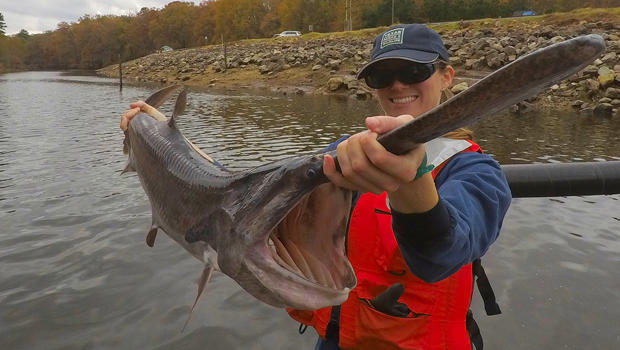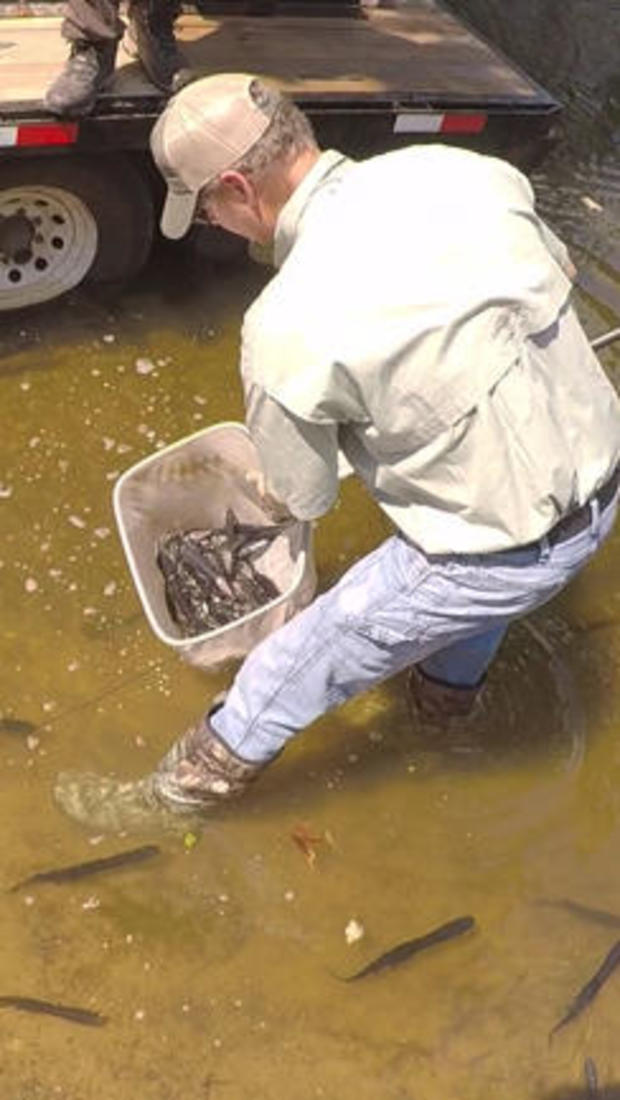Nature up close: Caddo Lake
By "Sunday Morning" contributing videographer Judy Lehmberg.
When compared to some of the geological wonders of North America, the unremarkable terrain of the East Texas piney woods doesn't stand out. But what it lacks in spectacular scenery it makes up for in biodiversity.
If you've never been to East Texas, you may not realize it is very different from the drier areas of the state. The wild, wet areas of East Texas are much like southern Louisiana – swampy areas full of alligators, cypress trees, and paddlefish. Caddo Lake (the subject of last week's Moment in Nature video) has all three. It sits on the northeastern border of this biologically diverse area and is home to the oldest animal in North America, paddlefish, and some of the oldest trees in the world, bald cypress.
Caddo Lake straddles the Texas-Louisiana border. Although it has been controlled by a man-made dam for many years, it was originally the largest naturally formed lake in Texas. It formed as a result of a huge, 100-mile long, log jam on the Red River in the late 1700s.
The dominant tree in and around Caddo Lake is the bald cypress, trees that can be extremely long-lived (at least 3,500 years), and can grow (slowly) to heights of up to 150 feet, and a diameter of 17 feet. The species has been around a long time, at least since the supercontinent Pangea broke up around 150 million years ago to become all of the continents we know today. Like their relatives the pines, cypress trees form cones rather than flowers, but like flowering trees (such as maple and oak), their leaves turn shades of orange and brown in the fall and are deciduous.
Paddlefish are another very old species living in Caddo Lake. In fact, they are the most ancient animals in North America. Their fossil record goes back between 300-400 million years, at least 50 million years before the first dinosaurs. Due to lose of habitat, over-fishing, pollution, barriers to fish movement, and lack of water flow necessary for spawning, paddlefish have been extirpated from some of their former range but are still found in the Ohio, Missouri and Mississippi river systems from Montana to the eastern U.S., and all the way south to the Gulf of Mexico. They are either endangered or threatened in some of the 22 states where they remain, but can be legally fished in 13 states.
Like sharks, paddlefish have a skeleton made of cartilage, and sensors on their snout that detect the electrical activity of their prey. Unlike sharks, paddlefish have no teeth, and catch plankton such as Daphnia and other zooplankton by opening their large mouth while moving through the water and using their gill rakers.
Because a dam was built to maintain Caddo Lake levels, the native paddlefish population suffered. They no longer had the spring high water fIows necessary for their spawning. To boost their populations, the U.S. Fish and Wildlife Service, along with Texas Parks and Wildlife, put young paddlefish into Caddo Lake in the 1990s to see if they would stay in the lake or leave over the spillway. The fish stayed.
Also during that time, interested groups (including the Texas Parks and Wildlife, the U.S. Fish and Wildlife and the Nature Conservancy) began meeting to determine how to establish a more natural flow of water from the dam. The goal was, and remains, to return flows to pre-dam times to increase the chances of paddlefish spawning, as well as establish more natural conditions.
Paddlefish have since been stocked into Caddo Lake in 2013, 2014 and 2016. Some of those fish were implanted with telemetry tags so their locations can be found. Many of the fish survived (or at least until the tags' batteries went dead) and are presumably still in the lake, so that original population has been supplemented several times. Paddlefish take a long time to reach sexual maturity. It is not yet known if they will reproduce in the lake, but to increase the odds of reproduction lake managers are releasing water to imitate spring floods. This not only helps the paddlefish but other inhabitants of the lake as well.
Tim Bister, fisheries biologist with Texas Parks and Wildlife, said, "We've seen some success from initial paddlefish stocking efforts – fish are not swimming downstream over the Caddo Lake spillway, and stocked fish are surviving and growing. With these encouraging results, Texas Parks and Wildlife and the U. S. Fish and Wildlife Service began a 10-year restocking program in 2018." The plan is to stock the lack with between 11,000 and 14,000 fish every year through 2027. "The ultimate goal of the stocking program is the reestablishment of a self-sustaining paddlefish population," he said.
Because paddlefish don't usually reproduce until they are at least ten years old, it will be a few years before we know how successful the program is. We already know the increase in spring water flows has made the lake healthier for other lake dwellers. Paddlefish are biological indicators. If they are doing well, that is a very positive sign that the entire lake and its inhabitants are healthy.
Now, fingers crossed, we wait for them to reproduce.
Watch a Texas Parks and Wildlife video of their restocking program:
Judy Lehmberg is a former college biology teacher who now shoots nature videos.
See also:
- Judy Lehmberg (Official site)
- Judy Lehmberg's YouTube Channel
To watch extended "Sunday Morning" Nature videos click here!





